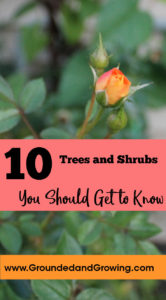 Are you looking for some unique trees and shrubs for your landscape? But not sure where to start? Let me introduce my ten favorite trees and shrubs that are not the same old same old. Plus they are easy maintenance. You read that right. Easy maintenance.
Are you looking for some unique trees and shrubs for your landscape? But not sure where to start? Let me introduce my ten favorite trees and shrubs that are not the same old same old. Plus they are easy maintenance. You read that right. Easy maintenance.
I’m tired of looking around and seeing the same trees and shrubs in every yard.
A lot of this same-ness relates to the reality that some plants are easier to grow than others, so we naturally grow more of those. I don’t know anyone, myself included, that sets out to make their garden as difficult as possible to maintain, needing constant attention.
Now there’s no shortage of unusual trees and shrubs to choose from. I’m a sucker for unusual and unique plants. They seem to fuel my inner plant addict.
When we first moved into our brand new house back in 2005 (in other words– absolutely no landscaping) I was like a kid in a candy shop. I bought way too many plants, and I bought more than a few without researching them. Some of those first plants were divas, needing constant attention to survive. We had no children at that point, and I thought I had all the time in the world.
Boy was I wrong.
Kids or not, diva plants don’t mix well with a busy schedule. One by one the diva plants disappeared.
But over the years my husband and I learned to do our homework researching plants, especially where trees and shrubs are concerned. These are the long-term residents on our property, and usually the most costly to purchase. They are also expensive and a pain in the you-know-what to replace if you have to dig out or chop down a dead one years later. Our goal was to plant as many unique, easy maintenance plants as possible.
These are some of our favorites– they have survived and thrived despite our busy life.
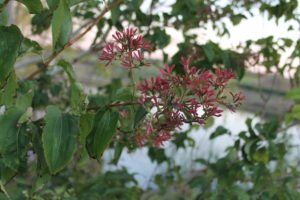
After the Seven Son’s white flowers fall, the structure left behind, called the calyx, turns bright red.
Seven Sons Tree (Heptacodium micanioides)– 15′ to 20′ tall; clusters of white flowers in early fall. Attractive peeling bark provides winter interest. The flowers, bark and overall form are very much like crepe myrtle (Lagerstroemia sp.) that is hardy in Zones 7 and up. Some people call Seven Sons the “Crepe Myrtle of the North”. Thrives in well-drained, average soil. Hardy in Zones 5 to 9.
Golden Raintree (Koelreuteria paniculata)– 30′ to 40′ tall. This tree can tolerate clay soil and drought. Big deal. The real reason I planted it is it is one of the only summer flowering trees that grows in my part of the world. Right around the 4th of July at my house this tree is covered in long clusters of bright yellow flowers (the “golden rain” of its name). Following the flowers, papery lantern-shaped seed capsules form. I have never noticed any seedlings sprouting from these capsules, but in some southern parts of the U.S., this is a problem and this tree is considered invasive. ** Update** One of the only issues with Golden Raintree is it will not tolerate poor drainage. We learned that the hard way when we lost our tree to the excessively wet spring of 2019. Hardy in Zones 5 to 9.
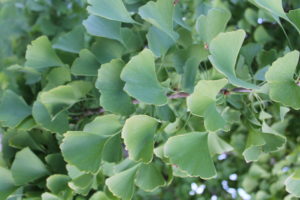
Gingko leaves are shaped unlike any other tree leaf.
Gingko (Gingko biloba)– 50′ to 80′ tall. Ancient tree that has few pests and diseases today. Slow growing tree that tolerates clay soil, road salt and urban conditions. Trees produce all male or all female flowers if grown from seed. Female trees produce fruit when pollinated that most people agree smells like vomit. Avoid this fragrant menace by purchasing a certified male tree from a nursery. Great fall color; tree sheds leaves all at once after freezing temperatures, simplifying leaf raking! Unique leaf shape will make your yard a popular stop for school leaf collections! Hardy in Zones 3 to 8.
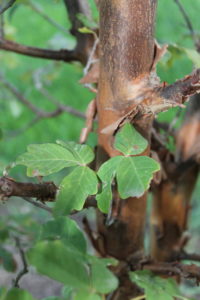
Paperbark maple leaves and bark are unlike any other maple.
Paperbark Maple (Acer griseum)– 20′ to 30′ tall. Extremely hard to propagate from seed or cutting and it’s slow growing, so this tree is more expensive than most. But it’s gorgeous exfoliating cinnamon-colored bark and bright red fall color make the expense worthwhile. Plus it will tolerate clay soil and doesn’t have any significant pests or disease issues, unlike a lot of other maples out there. Hardy in Zones 4 to 8.
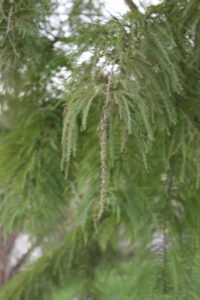
Baldcypress with feathery needles and male flower (center) hanging down.
Baldcypress (Taxodium distichum)–50′ to 70′ tall. This tree grows in a wide range of soils, but it loves wet feet; not many trees will tolerate moist soil all the time. If there is enough moisture present, baldcypress will grow knobby “knees” up from the roots. Our tree is the cultivar ‘Shawnee Brave™’which is more narrow and has denser foliage than the straight species. Baldcypress is a deciduous conifer; it produces round cones and has needle like leaves that the tree sheds in the fall. In the 10+ years we’ve had our tree, I’ve never once raked any of the leaves. They just blow away. Hardy in Zones 4 to 9.
Serviceberry (Amelanchier canadensis)– 15′ to 25′ tall. Truth be told– we haven’t planted this tree yet but will soon. I have every reason to believe it will be a winner. It tolerates a wide range of soils and is a great choice for more natural, relaxed landscapes. It tends to send up suckers from the roots which make it more like a multi-stemmed shrub if not removed. Whether you grow it single stemmed as a tree or a multi-stemmed shrub, you will get to enjoy spring flowers, summer berries (that are edible!), and gorgeous fall color. Definitely a plus in my book. It attracts a few minor pests and diseases. Hardy in Zones 4 to 9.
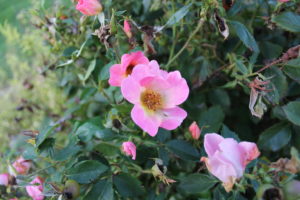
Rainbow Knock Out Rose has a unique yellow center.
Shrub Roses (Rosa x)– 3′ to 4′ tall. Reliable blooming from spring until fall and not as fussy as other roses. It annoys me that when you mention “shrub roses” most people assume you’re talking about the hot pink Knock Out® or Double Knock Out® roses that are wildly popular and a bit overused in my opinion (though I do have some of the hot pink ones in my yard). Did you know there is a whole rainbow of colors available in the Knock Out® series? While the Knock Out® is widely recognized for its disease resistant, super hardy and tolerant nature, there are other shrub roses on the market that are real troopers as well. I love ‘Oso Easy® Paprika’; I literally do nothing but cut it back in the spring and maybe give it a dose of fertilizer. It rewards me with hundreds of bright orange blooms with yellow centers from spring through fall. Knock Out® roses are hardy in Zones 5-11; Oso Easy® roses are hardy in Zones 3-9.
Re-blooming Lilac (Syringa x)– 3′ to 4′ tall. These shrubs provide the typical clusters of sweetly-scented spring flowers followed by sporadic flowering through summer into fall. I have an older cultivar, ‘Josee’ and love it. The newer cultivar on the market is ‘Bloomerang®’ which reportedly was bred from a cross including ‘Josee’. These shrubs rebloom more if they are deadheaded. I didn’t deadhead at all this year and while it did rebloom, it was noticeably less than other years when I took the time do remove old blooms. I have noticed that my reblooming lilac’s leaves do not develop a whitish coating of powdery mildew like my other traditional spring blooming lilac does– which is a nice bonus. Hardy in Zones 3-7.
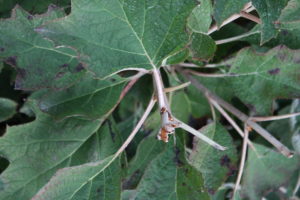
No flowers on our Oakleaf Hydrangea this year only because the deer found them tasty!
Hydrangeas that bloom every year— Less than 8′ tall. A question people ask me A LOT is how to get their hydrangeas to bloom. This topic could (and will) be a blog post of its own someday. Long story short– most people (myself included) see a hydrangea with huge pink or blue flowers and we have to have it. Now. It looks phenomenal. But then the next year– no flowers. Not a single one. What’s the problem? The tag said it would bloom year after year!
The problem is the big, showy, pink and blue bigleaf hydrangeas (Hydrangea macrophylla) bloom best on old wood– meaning the buds formed on last year’s stems. And it’s not uncommon for bigleaf hydrangea stems to die back to the ground each winter. So all of the spring growth is “new” growth from the plant’s crown underground. Newer bigleaf hydrangea cultivars like the Endless Summer® series advertise blooms on old and new wood. But often the blooms on new wood don’t appear until later in the season. My own bigleaf Endless Summer® hydrangeas didn’t start blooming until August this year and they’ve been in the ground for over 10 years!
If you want a hydrangea that you don’t have to worry about old vs. new wood and which buds survived, consider Panicle Hydrangea (Hydrangea paniculata) and Oakleaf Hydrangea (Hydrangea quercifolia). The flowers look a little different than the bigleaf hydrangeas, but they are much more reliable bloomers. Panicle Hydrangea is more winter hardy than Oakleaf (Zone 3 vs. Zone 5) but both have remarkably few insect and disease problems. About the only issue we’ve had is we discovered the local deer thought our Oakleaf Hydrangea flowers were tasty this year.
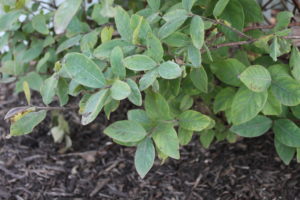
Honeyberry’s leaf shape and color gives away it’s honeysuckle heritage.
Honeyberry (Lonicera caerulea) — 2′ to 5′ tall. I discovered honeyberries after I had tried unsuccessfully to grow blueberries for several years. Blueberries need an acidic soil pH that I cannot maintain in my landscape without constant intervention. And ain’t nobody got time for that at my house. Honeyberries are a type of honeysuckle. You may have heard of honeysuckle within the context of invasive plants, as there are several species that are invasive and threatening our native ecosystems with their outrageous growth. Fortunately, honeyberries are not invasive. But like their invasive cousins, they are vigorous, strong plants and extremely cold tolerant. They grow in just about any soil, even heavy clay soil.
We have had relatively few problems with our plants. When they were first planted a rabbit ate one all the way to the ground and it bounced back. This year it looks like we may have lost one to overwatering since it was near a leaky hose. But we’ll see. It may surprise us like the bunny-eaten one. Honeyberry shrubs are early bloomers and so are one of the first fruits to harvest in late May or early June. The fruits look like oval-shaped blueberries, and they taste like a combination of raspberry and blueberry. I do literally nothing to my plants and there are tons of fruits. But I have yet to eat more than a handful. The birds LOVE honeyberries! If I can get some bird netting in place over my shrubs in time next year I should be able to harvest more. Hardy in Zones 3 to 8.
The busier life gets, the more I can appreciate a landscape that practically takes care of itself. I still have shiny object syndrome when it comes to unusual plants (Look! Pretty plants!) which has led to some poor choices over the years. Finding that Holy Grail of unique and easy maintenance plants are what I’m really after now. The gardener in me still wants to have things in my garden that are not as common. Using easy maintenance plants is one way I can spend more time enjoying the yard with my family and less time fussing with diva plants. And when life gets busy I don’t worry as much about the fate of my yard.
These plants can handle it.
If you liked this post, please subscribe to Grounded and Growing today and receive your copy of “15 Tips to Become a '15 Minute Gardener'” so you can spend less time working ON your garden and more time enjoying being IN your garden.! It’s absolutely free. When you join the Grounded and Growing community, you’ll finally take the garden off your “To-Do” list and allow yourself time to enjoy your garden and savor the peace and serenity there. I tell subscribers about new posts as soon as I hit ‘publish’ and send weekly-ish updates on what’s going on in my garden– good, bad AND ugly.

All Rights Reserved. © 2017 Jennifer Schultz Nelson
Where do you find 5he unusual trees. I had a list of trees. However, I couldnt find them and ended up settling for trees. They are beautiful and I love them because I couldnt grow them in Kansas.
Thanks for sharing your insight. I always get a kick out of it.
Any ideas about keeping weeds out of my strawberries? We have a nasty grass that is very aggressive.
Generally speaking, we’ve found the best, most unusual trees at independent garden centers. We’ve bought a few things online– but expect that these will be smaller than what you would find at a nursery. I keep my eyes and ears open for ideas and usually research online first. I’ve also learned that lots of independent garden centers will order specific trees if you ask. You will likely need to plan ahead, it’s not like you ask and they can get it next week, but most places figure if you’re asking, there are 10 other people that haven’t asked.
Grasses in strawberries are tough to deal with. I’ve seen the chemical sethoxydim (Poast) suggested for grassy weeds in strawberries. It selectively kills grasses and leaves the strawberries unharmed. If you don’t have mulch around your strawberries, adding some will help suppress weeds.